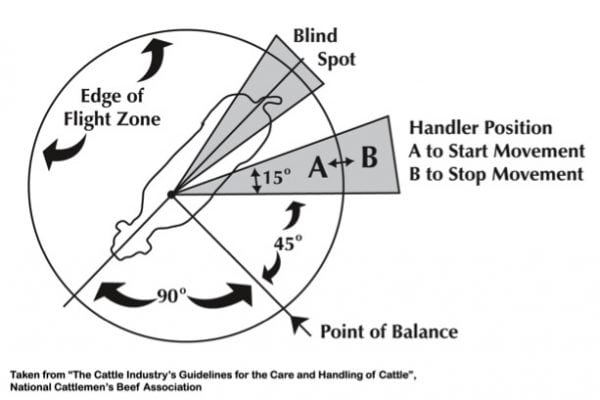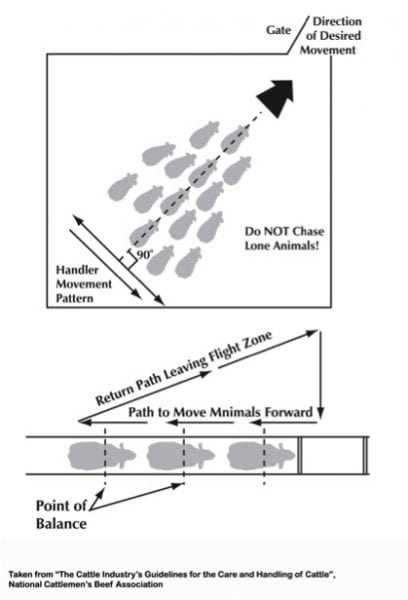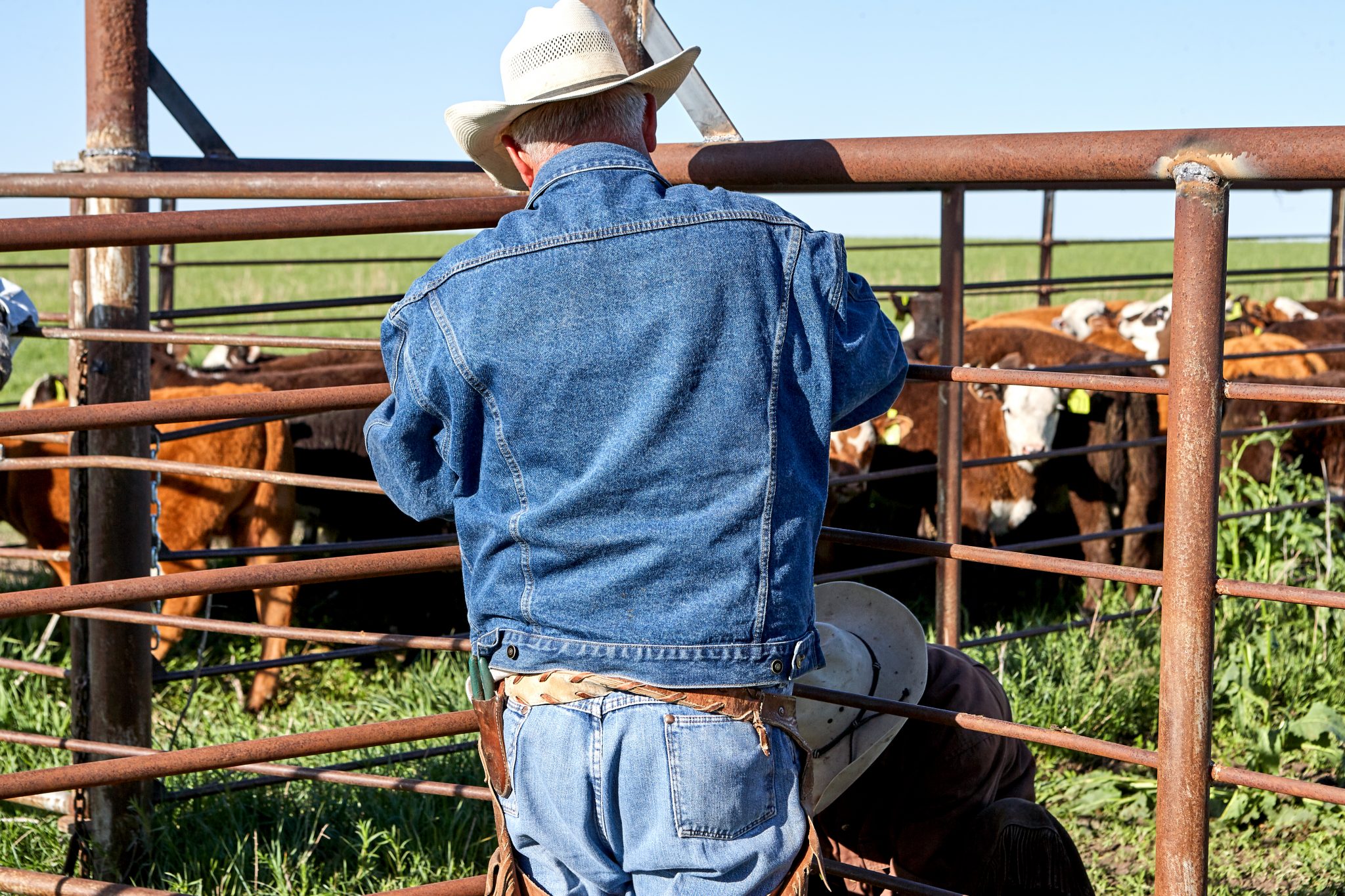Beef

Everyone involved in beef cattle production will at some time work cattle. Sound cattle handling practices will affect the well-being of cattle, individual animal health, and herd productivity. These practices are the result of decades of practical experience, research, and, most important, common sense.
Unfortunately, working cattle can be source of stress for you and your animals. Stressed cattle will have a poorer performance and a greater risk of health problems than nonstressed cattle. Minimizing stress is as simple as making the right thing easy and the wrong thing hard. Good handling techniques as well as functional facilities will more often than not actually save time and money. You will pay for handling facilities whether you own them or not.
The following points on handling and the use of cattle handling facilities will make working cattle easier for you and your animals.
Have a Plan
Have a plan for working cattle. Know what you are going to do long before you get cattle up. Having a simple list of what you are doing, the tools you need, and what cattle you are working is a start. Look at the overall flow pattern of cattle through the facility. Walk through the facility, making sure that everything is working and free from obstructions. Obstructions can be as simple as a closed gate or a coat hanging on the fence. Mud holes, drains, step-ups, shadows, and “zebra” lighting also obstruct smooth cattle flow. Cattle will work better and have less chance of injury if they can keep their footing, so make sure that alleys are not slick with mud or manure.
Have enough skilled labor to carry out your plan. Inexperienced people are easily frightened by cattle and may be hurt if they do not understand cattle behavior.
It helps if your workers or helpers know what they are doing and what you expect.
Cattle work better when they are handled frequently. Anything new or different causes them to become nervous and can lead to handling difficulty or production losses. Allow cattle to become familiar with the working pens by occasionally feeding in the pens or placing mineral feeders near the working area.
Weather can have a significant impact on cattle and human stress. While we cannot control the weather, we can plan activities around weather norms. Mid-day conditions in Alabama summers can be very hot and muggy. Avoid known periods of high temperature as you plan to work cattle. Watch the weather forecast. A heat index of 100 or above is dangerous for cattle and humans. A heat index of 100 may be a temperature of 85oF and 90 percent relative humidity or a temperature of 90oF and relative humidity of 60 percent. While Alabama is not known for cold winters, unseasonably cold temperatures can also cause stress-related problems. Avoid working cattle during or after a major cold front.
Understand Cattle Behavior
A good plan will work only if you follow it. When you start moving cattle, make sure that they are going where you want them to go. Cattle may run away when you enter a pasture and turning them will be difficult. Understanding your cattle’s flight zone will help get things started correctly. The direction an animal moves depends on where you enter the flight zone. Cattle will move forward when you enter behind the shoulder and backward when you enter in front of the shoulder. Entering the blind spot will cause cattle to stop, turn, and look at you. They want to know where you are at all times. In close quarters, you may be kicked if you get in a cow’s blind spot.

Figure 1. Flight zone
Taken from “The Cattle Industry’s Guidelines for the Care and Handling of Cattle,” National Cattlemen’s Beef Association
How close can you get to your cows before they move away? This distance is the edge of the flight zone (Figure 1). Cattle will move when you enter their flight zone and will stop when you leave it. The flight zone is larger when cattle are approached head-on, excitable, or not used to being handled. The flight zone is smaller when you confine the animal to a single-file chute or when the animals are used to being handled. Knowing the flight zone will help you work cattle with less stress (Figure 2).
Cattle are sensitive to sudden loud or high-pitched noises. Excessive noise makes cattle nervous and more difficult to work. The effects of shouting and banging depend on the temperament or disposition of the cattle. Tame, timid cattle may show little negative reaction. Nervous, flighty cattle may end up in the next county after a well-intended shout. In working facilities made of metal, avoid metal-on-metal contact. Install rubber bumpers where gates clang against metal. Avoid unnecessary shouting or other noise when possible.
Cattle have a strong herd instinct and become nervous or aggressive when alone. Work at least two or three animals at a time and have a dominant animal in the group. The fate of a cattle drive was often determined by identifying the lead steer. Understanding this basic concept of cattle behavior alone will reduce the stress of handling.

Figure 2. Moving Cattle
Taken from “The Cattle Industry’s Guidelines for the Care and Handling of Cattle,” National Cattlemen’s Beef Association
Opinions vary on the best way to move cattle. Some are convinced that working cattle on horseback is best, while others think working on foot is better. Remember that cattle do not like anything new. They are creatures of habit. According to Temple Grandin in BEEF magazine, August, 2009, cattle’s memories are sensory: pictures, sounds, and smells. A person on a horse or a four- wheeler is different than a person on the ground.
In the tight confines of a pen or alley, plastic paddles, sorting flags, or brooms can be used to move cattle. Each uses sight or sound to get cattle to move. Sorting flags and brooms provide a visual barrier; plastic “rattle” paddles provide both a visual barrier and an audible noise. A sorting stick works as a subtle prod, much like a solid wall but easy to handle. None of these tools is designed to strike animals, nor should they be used that way. When used correctly, each can be a valuable tool for minimizing stress during handling.
Avoid Injury
Many injuries to cattle or the people working cattle can be prevented by planning and understanding cattle behavior. Paying attention while working cattle will further reduce the incidence of injury.
Pay close attention to the facilities. Gates and panels can break or come loose, causing protruding objects, sharp corners, low overhangs, or other traps that can harm animals or humans.
Cattle are large, strong, and often unpredictable. It is unwise to relax around them too much or to try to work them without adequate facilities. Cattle are stronger than humans, and humans are smarter than cattle; therefore, humans should try to outthink cattle, not outwrestle them. If available, use the catwalk along the cattle working or loading chutes to work cattle rather than standing behind them.
Stay alert when working cattle. Cattle usually become unruly when least expected. Make certain that everyone is cautious at all times. If workers become fatigued, it is best to rest awhile.
If cattle are to be worked in close quarters, either work close to the animals or stay out of kicking range. Cattle cannot kick hard when you are very close. This is not recommended, however, because the danger of being stepped on is greatly increased.
Cattle that are not properly restrained in good facilities can cause accidents by throwing their heads or kicking. This may result in dangerous, painful jabs by vaccination needles, castration knives, or implanting tools. It is also difficult to deliver precise dosages of vaccines, pour-on insecticides, dewormers, or other products without good facilities. Improperly delivered product dosages can increase animal stress by inducing overdose reactions or, alternately, by not doing the proper job because too little product is delivered.
Many of the tools and products used in working cattle can be harmful if improperly used. Read and follow directions carefully. Accidental ingestion of chemicals by humans, spilling certain products (especially organophosphates) on the skin or in the eyes, or accidental injection can be stressful to people. If accidents happen, contact a physician immediately. Take the label with you so the physician can have full knowledge of the product that is causing the problem.
Keep a first-aid kit available near the cattle working area. First-aid training is recommended to handle possible emergencies.
Summary
Careful planning, understanding cattle behavior, and paying attention to details will reduce the stress associated with working cattle.
When you start thinking about getting cattle up to work, remember the following:
- Have a plan
- Have enough skilled labor
- Make sure the facilities are ready
- Remember that the initial movement determines everything
- Don’t get stressed yourself
For more information on the Alabama Beef QualityAssurance program, visit www.alabamabqa.com.

